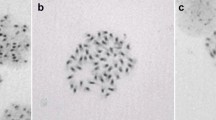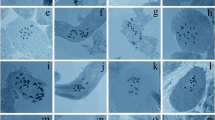Abstract
Karyotypes, constitutive heterochromatin and nucleolar numbers of five recognized taxa and two systematically new populations ofGuizotia have been studied using Giemsa or aceto-orcein staining, C-banding and silver nitrate staining. All accessions have 2n = 30 chromosomes, but satellite chromosome number and nucleolar number varied from four to eight. Centromere positions varied from predominantly median to submedian and subterminal in different materials. The satellites and an interstitial region in the short arm of one chromosome pair were C-banded in all materials. Telomeric and centromeric C-bands were also observed. The material could be classified into three groups, indicating possible phylogenetic relationships.
Similar content being viewed by others
References
Baagøe, J., 1974: The genusGuizotia (Compositae). A taxonomic revision. — Bot. Tidskr.69: 1–39.
Bentzer, B., Bothmer, R., Engstrand, L., Gustafsson, M., Snogerup, S., 1971: Some sources of error in the determination of arm ratios of chromosomes. — Bot. Not.124: 65–74.
Dagne, K., Heneen, W. K., 1992: The karyotype and nucleoli ofGuizotia abyssinica (Compositae). — Hereditas117: 73–83.
Friis, I., 1971: A new species ofGuizotia (Compositae) from north east tropical Africa. — Norw. J. Bot.18: 231–234.
Gelin, O. E. V., 1934: Embryologische und zytologische Studien inHeliantheae-Coreopsidinae. — Acta Horti Berg.11: 99–128.
Hiremath, S. C., Murthy, H. N., 1988: Domestication of niger (Guizotia abyssinica). — Euphytica37: 225–228.
—, —, 1992: Cytogenetical studies inGuizotia (Asteraceae). — Caryologia45: 69–82.
—, —,Salimath, S. S., 1992: Quantitative nuclear DNA differences associated with genome evolution inGuizotia (Compositae). — Genetica85: 241–247.
Levan, A., Fredga, K., Sandberg, A. A., 1964: Nomenclature for centromeric position on chromosomes. — Hereditas52: 201–220.
Matern, B., Simak, M., 1968: Statistical problems in karyotype analysis. — Hereditas59: 280–288.
Patel, O. P., Singh, C. B., Mishra, R. K., Gour, V. K., 1983: Karyological studies inGuizotia abyssinica Cass. — Cytologia48: 221–230.
Richharia, R. H., Kalamar, W. J., 1938: Somatic and meiotic chromosomes inGuizotia abyssinica Cass. — Cytologia9: 249–253.
Riley, K. W., Belayneh, H., 1989: Niger. — InRöbbelen, G., Downey, R. K., Ashri, A., (Eds): Oil crops of the world: their breeding and utilization, pp. 394–403. — New York: McGraw-Hill.
Seegeler, C. J. P., 1983: Oil plants in Ethiopia, their taxonomy and agricultural significance, pp. 122–146. — Wageningen: Center for Agricultural Publishing and Documentation.
Sumner, A. T., 1990: Chromosome banding, pp. 206–219. — London: Unwin Hyman.
Author information
Authors and Affiliations
Rights and permissions
About this article
Cite this article
Dagne, K. Karyotypes, C-banding and nucleolar numbers inGuizotia (Compositae). Pl Syst Evol 195, 121–135 (1995). https://doi.org/10.1007/BF00982319
Received:
Revised:
Accepted:
Issue Date:
DOI: https://doi.org/10.1007/BF00982319




